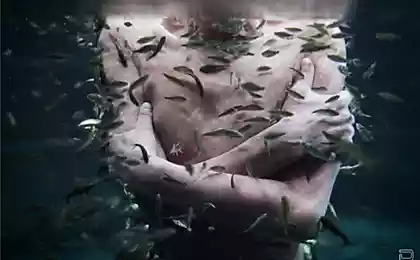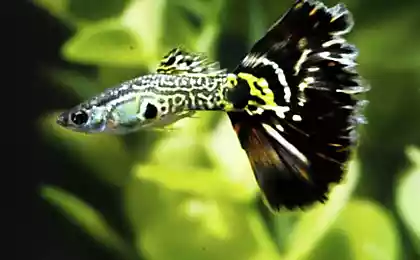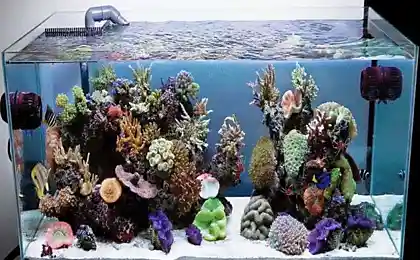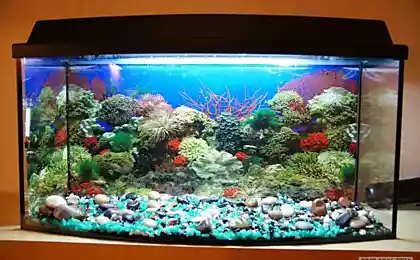530
Aquarium: the content of viviparous fish
Live-bearing aquarium fish is one of the honorable places among all the inhabitants of the aquarium. In addition, the fish perfectly fit into any interior. Often the interest in the aquarium begins with the content of viviparous species of fish.
Live-bearing aquarium fish – it's a real boon for aquarists, because they are completely unpretentious and undemanding. This explains a genuine interest in them by beginner aquarists. A distinctive feature of these fish is, of course, the birth of a female already formed viable fry. In other words, they don't spawn. It is worth noting that in nature these fish are quite common, and in the home is mainly contained guppies and swordtails.
Eighty five million five hundred thirty thousand forty
The content of viviparous fishes. Photo: thinkstockphotos.com
Live-bearing aquarium fish – it's a real boon for aquarists, because they are completely unpretentious and undemanding. This explains a genuine interest in them by beginner aquarists. A distinctive feature of these fish is, of course, the birth of a female already formed viable fry. In other words, they don't spawn. It is worth noting that in nature these fish are quite common, and in the home is mainly contained guppies and swordtails.
The most common live-bearing aquarium fish are guppies. Their females look distinctly different from the males and can reach a length of 5 cm in addition, they are painted much brighter males, the dimensions of which reach a length of not more than 3 cm Guppy is absolutely undemanding to the temperature of the water in the aquarium. Moreover, for their maintenance it is not necessary to install special equipment. Most importantly – keep the temperature range within 22-26°C. Aquarists are advised to adhere to a level of acidity ranging from 6.5 to 8.5.
Twenty three million four hundred thirty four thousand three hundred fifty
The most common live-bearing aquarium fish are guppies. Photo: thinkstockphotos.com
All would do well planted aquarium with guppies, small-leaved plants and mosses. They, like the "top" of the algae will be able to hold the fry on the surface of the water, not allowing an inexperienced fish to fall to the bottom and become food for the adults. A good barrier that protects the young from the older generation, will be the floating plants with hanging roots. Adult guppies need to be fed only once a day, and youngsters three times. For this approach both live feed and dry. As you can see, the requirements for the content of viviparous fish guppies are very simple and pobremente.
Beautiful live-bearing aquarium fish are brightly colored swordtails. Their name speaks for itself: the males of this fish are equipped with an elongated lower appendage of the caudal fin, resembling a sword. Females of the same "swords" are not. Swordtails, like guppies, absolutely easy to care for: water temperature in the aquarium should be around 20-25 Degrees, and acidity is 6.5. You should know that the platypus is a fairly active creatures, so their content is well suited to elongated aquarium. In addition, swordtails can be kept in one tank with guppies. The main thing that the aquarium they were not small.
The sword – fish prolific. It should be noted that swordtails, like guppies, aggressive enough to react to the newborn fry as live food. Therefore, when breeding these fish, the aquarium should be planted "top" algae, mosses and other plants in which the fry can hide from their angry parents. In addition to the above two types of aquarium viviparous fishes, there are, of course, and others. They are perfect for breeding at home. For example, one of the most popular fish are platies and mollies. Their contents are identical to the contents guppies and swordtails. published
P. S. And remember, only by changing their consumption — together we change the world! ©
Join us in Facebook and in Vkontakte, and we're Classmates
Source: domashniy.ru/
Live-bearing aquarium fish – it's a real boon for aquarists, because they are completely unpretentious and undemanding. This explains a genuine interest in them by beginner aquarists. A distinctive feature of these fish is, of course, the birth of a female already formed viable fry. In other words, they don't spawn. It is worth noting that in nature these fish are quite common, and in the home is mainly contained guppies and swordtails.
Eighty five million five hundred thirty thousand forty
The content of viviparous fishes. Photo: thinkstockphotos.com
Live-bearing aquarium fish – it's a real boon for aquarists, because they are completely unpretentious and undemanding. This explains a genuine interest in them by beginner aquarists. A distinctive feature of these fish is, of course, the birth of a female already formed viable fry. In other words, they don't spawn. It is worth noting that in nature these fish are quite common, and in the home is mainly contained guppies and swordtails.
The most common live-bearing aquarium fish are guppies. Their females look distinctly different from the males and can reach a length of 5 cm in addition, they are painted much brighter males, the dimensions of which reach a length of not more than 3 cm Guppy is absolutely undemanding to the temperature of the water in the aquarium. Moreover, for their maintenance it is not necessary to install special equipment. Most importantly – keep the temperature range within 22-26°C. Aquarists are advised to adhere to a level of acidity ranging from 6.5 to 8.5.
Twenty three million four hundred thirty four thousand three hundred fifty
The most common live-bearing aquarium fish are guppies. Photo: thinkstockphotos.com
All would do well planted aquarium with guppies, small-leaved plants and mosses. They, like the "top" of the algae will be able to hold the fry on the surface of the water, not allowing an inexperienced fish to fall to the bottom and become food for the adults. A good barrier that protects the young from the older generation, will be the floating plants with hanging roots. Adult guppies need to be fed only once a day, and youngsters three times. For this approach both live feed and dry. As you can see, the requirements for the content of viviparous fish guppies are very simple and pobremente.
Beautiful live-bearing aquarium fish are brightly colored swordtails. Their name speaks for itself: the males of this fish are equipped with an elongated lower appendage of the caudal fin, resembling a sword. Females of the same "swords" are not. Swordtails, like guppies, absolutely easy to care for: water temperature in the aquarium should be around 20-25 Degrees, and acidity is 6.5. You should know that the platypus is a fairly active creatures, so their content is well suited to elongated aquarium. In addition, swordtails can be kept in one tank with guppies. The main thing that the aquarium they were not small.
The sword – fish prolific. It should be noted that swordtails, like guppies, aggressive enough to react to the newborn fry as live food. Therefore, when breeding these fish, the aquarium should be planted "top" algae, mosses and other plants in which the fry can hide from their angry parents. In addition to the above two types of aquarium viviparous fishes, there are, of course, and others. They are perfect for breeding at home. For example, one of the most popular fish are platies and mollies. Their contents are identical to the contents guppies and swordtails. published
P. S. And remember, only by changing their consumption — together we change the world! ©
Join us in Facebook and in Vkontakte, and we're Classmates
Source: domashniy.ru/























